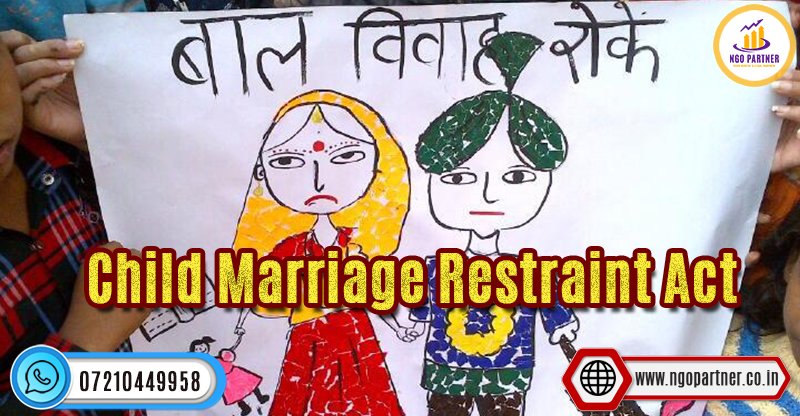
- June 16, 2023
- NGO Partner
- 0 Comments
- 831 Views
- 0 Likes
- Marketing Company Blogs
Child Marriage Restraint Act: Protecting Children, Safeguarding Futures
Child Marriage Restraint Act
Child marriage restraint act, a grave violation of human rights, refers to the marriage of a child below the age of 18. It is a deeply concerning practice that affects millions of children worldwide, hindering their growth, development, and overall well-being. To address this pressing issue and protect children from the harmful consequences of early marriage, governments have enacted laws such as the Child Marriage Restraint Act.

The Child Marriage Restraint Act is a crucial legal framework designed to prevent child marriages and safeguard the rights of children. It sets age restrictions for marriage, emphasizes the importance of free and full consent, and imposes penalties on those involved in facilitating child marriages. This act aims to ensure that children are given the opportunity to grow, learn, and pursue their dreams before entering into a lifelong commitment.
Addressing child marriage is of paramount importance. It not only protects the rights of children but also contributes to social and economic development. By preventing early marriages, we can enable children, particularly girls, to complete their education, develop vital life skills, and make informed decisions about their future. Additionally, combating child marriage promotes gender equality, reduces poverty, and fosters healthier and more prosperous societies.
In this blog, we will delve deeper into the Child Marriage Restraint Act, exploring its provisions, impact, challenges, and preventive measures. Join us as we unravel the significance of addressing child marriage and working together to protect children and safeguard their futures.
Historical Background
Child marriage is a practice deeply rooted in history, and efforts to combat it have evolved over time. The origin of the Child Marriage Restraint Act can be traced back to the early 20th century when countries recognized the need to protect children from the detrimental effects of early marriage. The act has undergone several revisions and amendments to address emerging challenges and align with changing societal norms.
Efforts to combat child marriage have gained momentum globally. Governments, international organizations, and civil society have recognized the urgency to protect children’s rights and address the underlying causes of this harmful practice. Various campaigns, advocacy initiatives, and awareness programs have been launched to raise awareness about the consequences of child marriage and advocate for legal reforms.
Key Provisions of the Child Marriage Restraint Act
Age of Marriage
The Child Marriage Restraint Act sets a minimum age for marriage for both females and males. This age varies across countries but generally ranges from 18 to 21 years. Exceptions and conditions may exist in certain circumstances, such as parental consent or court approval. However, the aim is to ensure that individuals enter into marriage when they are physically, emotionally, and mentally prepared.
Consent and Guardianship
One of the fundamental provisions of the act is emphasizing the importance of free and full consent in marriage. It recognizes that individuals should have the right to choose their life partner willingly and without coercion. Additionally, the act highlights the role of guardians, such as parents or legal representatives, in preventing child marriage by ensuring the well-being and best interests of the child.
Offenses and Penalties
The Child Marriage Restraint Act strictly prohibits child marriage and imposes penalties on those involved. Offenders, including parents, guardians, and even religious or community leaders, can face legal consequences. Law enforcement agencies play a crucial role in investigating reported cases, prosecuting offenders, and ensuring the implementation of the act’s provisions.
Impact and Challenges
Positive Impact
The Child Marriage Restraint Act has had a significant positive impact on society. By preventing child marriages, it protects children from exploitation, abuse, and harmful practices associated with early marriage. It also enables children, especially girls, to access education, develop essential skills, and pursue their dreams. Moreover, it empowers girls and women by providing them with opportunities for personal growth, career advancement, and active participation in social and economic activities.
Challenges and Implementation Issues
Addressing child marriage comes with its share of challenges. Social and cultural factors deeply ingrained in communities may perpetuate the practice. Lack of awareness about the legal provisions and the negative consequences of child marriage poses a significant obstacle. Furthermore, the effective implementation of the act requires collaboration among multiple stakeholders, including government agencies, civil society organizations, and community leaders.
It is essential to overcome these challenges by conducting comprehensive awareness campaigns, educating communities about the detrimental effects of child marriage, and fostering collaboration among different sectors. Building a strong support system, providing access to social services, and strengthening enforcement mechanisms are crucial steps towards effectively implementing the Child Marriage Restraint Act and protecting children’s rights.
Preventive Measures and Interventions
Awareness and Education
To combat child marriage effectively, awareness and education play a pivotal role in changing mindsets and promoting a culture that values children’s rights and well-being.
Community Awareness Campaigns: Launching targeted campaigns to raise awareness about the consequences of child marriage within communities. These campaigns can involve community leaders, activists, and local influencers to disseminate information, debunk myths, and foster discussions on alternative practices.
School-Based Programs: Integrating comprehensive sexuality education and gender-sensitive curricula into school systems. By empowering students with knowledge about their rights, the risks of child marriage, and the importance of education, we can equip them to make informed choices and challenge harmful norms.
Engaging with Parents and Community Leaders: Conducting workshops, seminars, and dialogues with parents, guardians, and community leaders to address their concerns, dispel misconceptions, and promote the benefits of delaying marriage. Encouraging their active participation can create a supportive environment for preventing child marriages.
Empowering Girls and Communities
Empowerment initiatives are essential for breaking the cycle of child marriage and ensuring the holistic development of girls and communities.
Access to Education and Skill Development: Enhancing access to quality education for girls, ensuring they have the knowledge and skills to pursue their aspirations. Scholarships, school infrastructure improvements, and vocational training opportunities can open doors for girls and provide them with better prospects for the future.
Economic Empowerment Programs: Promoting income-generating activities, entrepreneurship, and vocational training for girls and women. By equipping them with skills and resources, they can become financially independent, reducing their vulnerability to early marriage.
Strengthening Support Systems and Social Services: Establishing robust support systems that provide counseling, legal aid, and social services for at-risk girls and their families. Creating safe spaces and helplines can ensure they have the necessary support and protection.
Future Outlook and Recommendations
Legal Reforms and Policy Changes
Strengthening the Child Marriage Restraint Act: Reviewing and amending the legislation to enhance its effectiveness and align it with evolving societal norms. Strengthening penalties, ensuring stricter enforcement, and introducing provisions for comprehensive rehabilitation and support can further safeguard children’s rights.
Closing Legal Loopholes: Identifying and closing any gaps or inconsistencies within the law to prevent exploitation and ensure consistent application across regions.
Addressing Cross-border and Inter-state Challenges: Formulating mechanisms to address child marriage cases that transcend borders or occur across different states within a country. Cooperation between authorities and sharing of information can help combat these challenges effectively.
Multi-sectoral Collaboration
Government, NGOs, and Civil Society Partnership: Encouraging collaboration between government agencies, non-governmental organizations, and civil society to pool resources, share expertise, and implement comprehensive programs and interventions.
International Cooperation and Advocacy: Engaging in global collaborations to share best practices, learn from successful initiatives in other countries, and advocate for child rights and the eradication of child marriage on international platforms.
Sharing Best Practices and Learning from Global Experiences: Creating platforms for knowledge exchange, where stakeholders can share successful strategies, lessons learned, and innovative approaches to address child marriage.
In Conclusion, the Child Marriage Restraint Act stands as a powerful tool in the fight against child marriage, safeguarding the rights of children and shaping a better future for them. Through this blog, we explored the key provisions, preventive measures, and challenges surrounding child marriage. The urgency to combat this harmful practice is clear. Every child deserves a childhood, an education, and the freedom to determine their own path. It is our collective responsibility to raise awareness, advocate for legal reforms, empower girls and communities, and strengthen support systems. Together, let us work tirelessly to create a world where no child is robbed of their rights and where child marriage is only a distant memory. Join us in our call to action for a future free from child marriage.




Leave a Comment